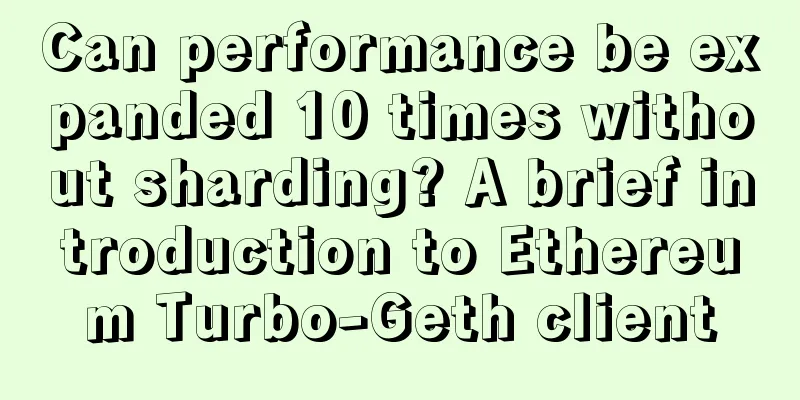Can performance be expanded 10 times without sharding? A brief introduction to Ethereum Turbo-Geth client

|
Turbo-Geth started in 2017 (yes, during the crazy CryptoKitties-induced congestion) as a purely curious project. It started out as an exploration of alternatives to trie-based database schemas. In March 2018, the Turbo-Geth project received a small bonus ($25,000) from the Ethereum Foundation. In the first and second quarters of 2019, Turbo-Geth was used as a state analysis platform for State Rent research. By the third and fourth quarters of 2019, Turbo-Geth was also used to perform back testing of stateless Ethereum. Before Devcon5, I thought it was already solid in concept. At Devcon5, I proposed to stop accepting EIPs within a year so that all implementations can be converted to similar data models. However, due to doubts and lack of enthusiasm from the "core developers" group, my proposal was not adopted. The skepticism was mainly around ways to efficiently compute and update the state root hash. At EthCC 2020 in March 2020, we proposed a solution: an additional data structure called “Intermediate Hashes”. We fully implemented this solution in the following months. The idea for staged sync came from observing per-table write churn measurements. The solution to data churn is to insert data in a pre-ordered sequence. We observed these phenomena carefully in late 2019, but our first experimental implementation showed significant performance benefits in February 2020. Phased synchronization was a very significant change at the architectural level (but without major changes to the data model), and we implemented this feature from March to July 2020. Thanks to it, we were able to significantly (10 times) reduce the synchronization time. In August 2020, we found a way to reduce the state representation data from 50 GB to 10 GB. In September 2020, the “intermediate hash value” feature was made more granular, increasing the speed of calculating the state root hash by 4 times (from 200 ms to 50 ms) while reducing its data size from 7 GB to 2.5 GB. We are currently developing a proper indexing of logs. So what does all this mean? In fact, this doesn't mean anything, because the current implementation has not yet reached the efficiency limit. There are still a few "unsolved mysteries":
SilkwormThe idea of creating a modular Ethereum implementation written in C++ under the Apache 2.0 protocol began in early 2019, as we saw that the "Aleth" project had been largely abandoned. But it wasn't a good time. In May-June 2020, the time finally came. There were four major turning points:
futureStarting the Silkworm project also opened up our minds, for example, we can migrate the implementation piece by piece to other programming languages (such as Rust). I believe that Ethereum 1.0 can expand throughput by at least 10 times even without the introduction of sharding. We are facing three main challenges:
Link to this article: https://www.8btc.com/article/649566 |
<<: Survey shows 26% of institutional investors intend to increase their cryptocurrency holdings
>>: Mining difficulty hits a new high, dry season is approaching, BTC miners are really worried
Recommend
Is it good for a woman to have a mole on her right little finger? How is your destiny?
Moles can be divided into broad and narrow meaning...
How to see children from the child lines of the marriage line
The small vertical lines on the marriage line are...
Analysis of the fortune of a woman with carrot legs
In fact, from the perspective of physiognomy, the...
What is the fortune for a man with a mole on the sole of his right foot? Detailed explanation of a man having a mole on the right sole of his foot
In physiognomy, some moles are considered auspici...
Detailed explanation: What does the wisdom line on palmistry represent?
Physiognomy is a science that was derived from th...
What are the facial features and signs of a woman cheating?
Cheating is an extremely bad thing, no matter wha...
Are traditional banks interested in Bitcoin? Bank of America, the second largest bank in the United States, obtains patent for cryptocurrency exchange
Bank of America (BOA), the second largest bank in...
How to tell a woman's health from her face
As the saying goes: Appearance is determined by t...
Why does traditional Chinese aesthetics attach importance to the chin?
People with wide chins are born with flesh and bo...
Bitcoin is a great tool to bring about a financial revolution
Bitcoin is a great tool that can bring about a fi...
The influence of fingers on a person's personality
Fingers have a great relationship with a person&#...
People's Daily: New technologies lead the evolution of digital currency, and good money drives out bad money
Recently, the impact of electronic payment techno...
What does it mean to have a birthmark on your hand?
In physiognomy, bone structure can tell a person&...
Tell you which women you can't marry based on your face
Getting married is a very important thing in life...
In addition to palmistry, how much do you know about the money line?
When it comes to palm reading, everyone’s first r...









